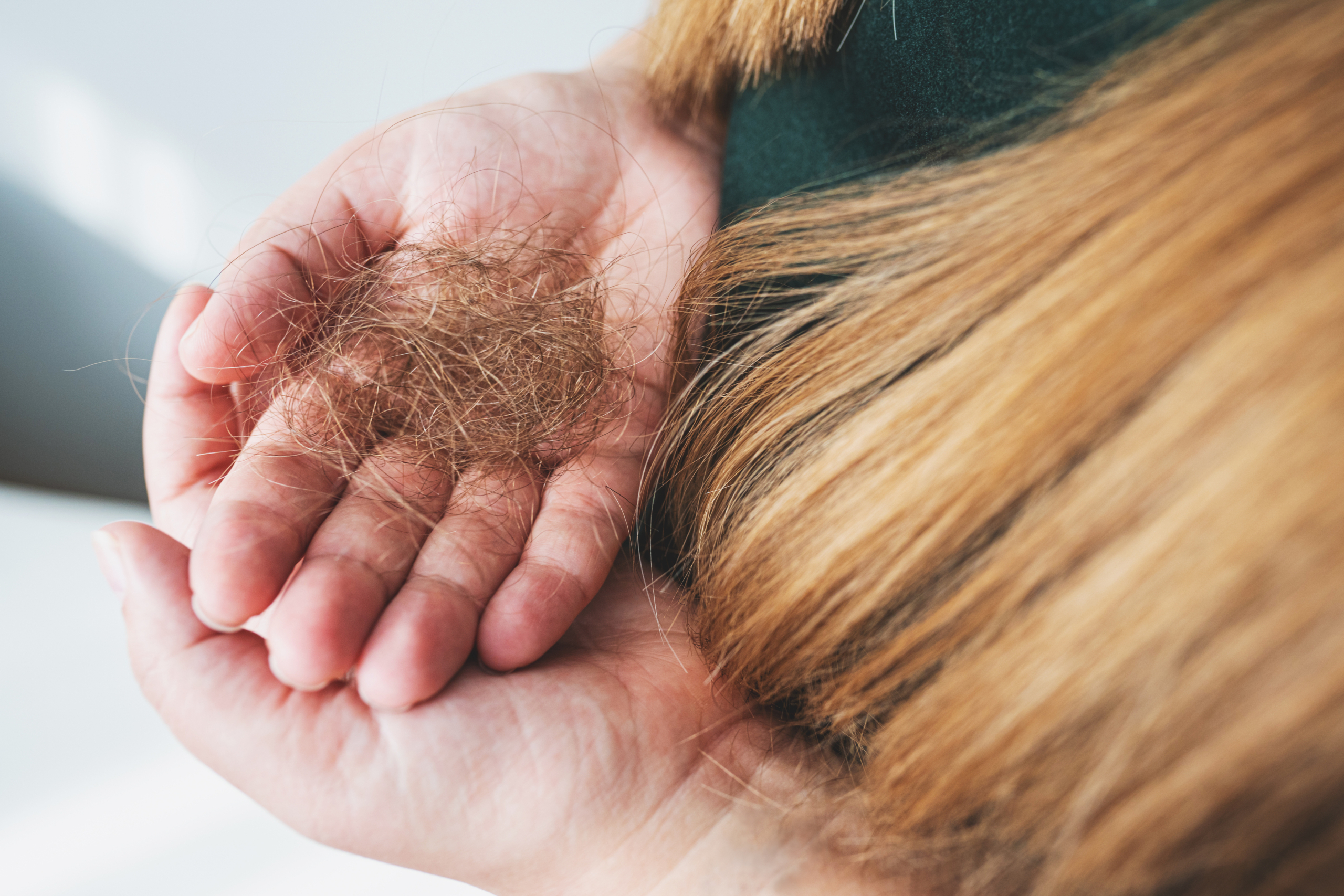What’s the Difference Between Hair Shedding & Hair Growth?
 As a world-renowned board-certified dermatologist, Dr. Ben Behnam answers the question of why you may experience a shedding phase once you start your hair growth treatments. Hair shedding and hair growth are two distinct, but equally important natural processes in the hair growth cycle that can happen at the same time. Understanding the difference between them can help you stick to your hair growth solutions and maintain the results you’re seeing. Dr. Ben Behnam explains everything you need to know about the differences between hair growth and shedding, in addition to understanding the science behind hair growth ingredients work to stimulate growth. Understanding the ingredients that go into your hair growth solutions and what you may experience with topical versus oral medications, can help you talk to your dermatologist about making adjustments to your formula as you go.
As a world-renowned board-certified dermatologist, Dr. Ben Behnam answers the question of why you may experience a shedding phase once you start your hair growth treatments. Hair shedding and hair growth are two distinct, but equally important natural processes in the hair growth cycle that can happen at the same time. Understanding the difference between them can help you stick to your hair growth solutions and maintain the results you’re seeing. Dr. Ben Behnam explains everything you need to know about the differences between hair growth and shedding, in addition to understanding the science behind hair growth ingredients work to stimulate growth. Understanding the ingredients that go into your hair growth solutions and what you may experience with topical versus oral medications, can help you talk to your dermatologist about making adjustments to your formula as you go.
At Happy Head, our hair growth solutions are customized to your needs, sex, medical history, and hair growth goals, made fresh to order and shipped to your door. Custom ingredients at their highest strengths can get you the results you want in just a few months. So what’s the difference between hair shedding and hair growth?
Let’s walk through what defines these various stages of the hair growth cycle and get familiar with the reason you may see shedding.
Understanding the Hair Growth Cycle
For new hair to grow, your existing hair follicles go through three main stages: anagen, catagen, and telogen. The anagen phase is known as the primary growth phase and can last anywhere from 2 to 7 years, depending on genetics and overall health. During this stage, your hair grows approximately half an inch every month. (1)
The catagen phase follows anagen, which lasts about 10 days. This stage signals a transitional period where the hair follicle gets ready to shed its old hair before entering into the resting phase known as telogen. In telogen, your hair stops growing and falls out naturally. This happens after just a few months. It’s estimated that about 10% of our scalp hairs are in this stage at any given time. Which phase or growth stage you’re in will vary by person and not every hair on your scalp will be in the same phase. When the growth phase stops due to stress, when you accumulate Dihydrotestosterone (DHT) in your hair follicle it is possible to see growth.
When you start to incorporate hair growth products that target this stress hormone and manage your stress levels, the ingredients block stress hormones from accumulating (DHT) and allow the hair to reenter the growth phase as normal. Of course, not all hair loss is due to stress but could be linked to an underlying health concern or genetic condition so it’s important to see a dermatologist to understand which types of hair loss are treatable. Hair growth can happen if the hair follicle is still present and simply dormant.
What Happens When Hair Sheds?
Hair shedding refers to the the telogen phase of hair growth when the hairs finally fall out after completing their cycle. On average, we lose anywhere from 50-100 strands of hair per day through shedding alone, which is totally normal and should not be cause for concern. Shedding 100 hairs a day is nothing to worry about unless it becomes excessive or accompanied by other symptoms such as itching or inflammation of the scalp.
While individual rates of shedding may vary due to genetics and external factors like stress or diet, consistent levels of shedding indicate a healthy process of renewal within your hair follicles. Dr. Behnam explains that only a small percentage of people, about 5%, see shedding when they start a new hair growth treatment.
If you’re concerned about hair shedding when you start hair growth treatments with Happy Head, your assigned dermatologist can help answer any questions and make adjustments to your formula as needed.
Ingredients for Hair Growth Success
At Happy Head, we formulate our hair growth solutions with the highest concentration of FDA-approved ingredients available. Here are some you can find in yours:
- Finasteride: Stops hair loss and regrows hair by targeting the enzyme that converts Testosterone to DHT. Clinically proven to grow hair. For men (age 18+) and women (age 50+). Not recommended if you or your partner are breastfeeding, pregnant, or planning to become pregnant
Products Including Finasteride:-
- Topical Finasteride & Minoxidil
- Topical Finasteride, Dutasteride & Minoxidil (Advanced Formula)
- Topical Finasteride & Minoxidil (Aqueous Formula)
- Topical Finasteride & Minoxidil (Liposomal Formula)
- Topical Latanoprost, Finasteride & Minoxidil
- SuperCapsule™ Finasteride, Minoxidil & Vitamin D3
- Oral Finasteride (FDA Approved)
-
- Dutasteride: Stops hair loss and regrows hair by blocking the two enzymes that convert Testosterone to DHT. A stronger version of Finasteride. For anyone who hasn’t seen results from Finasteride, men (age 18+) and women (age 50+).
Products Including Dutasteride: - Spironolactone: Stops hair loss and regrows hair by blocking DHT from attaching to its receptors. For women under 50 only. Not recommended if you’re breastfeeding, pregnant, or planning to become pregnant.
Products Including Spironolactone: - Minoxidil: Promotes hair growth by extending the anagen (hair growth) phase. Clinical studies show best results when Minoxidil is combined with Retinoic Acid. Our topical Minoxidil is the strongest available at 6% for women and 8% for men. Our Minoxidil is the highest concentration available compared to competitors. For men and women.Products Including Minoxidil
- Topical Minoxidil
- Topical Finasteride & Minoxidil
- Topical Dutasteride & Minoxidil
- Topical Spironolactone & Minoxidil (Women’s Formula)
- Topical Finasteride, Dutasteride & Minoxidil (Advanced Formula)
- Topical Finasteride & Minoxidil (Aqueous Formula)
- Topical Finasteride & Minoxidil (Liposomal Formula)
- Topical Latanoprost, Finasteride & Minoxidil
- SuperCapsule™ Finasteride, Minoxidil & Vitamin D3
- SuperCapsule™ Dutasteride, Minoxidil & Vitamin D3
- SuperCapsule™ Spironolactone, Minoxidil & Vitamin D3
- Oral Minoxidil
Now you know the difference between hair growth and hair shedding, you’re ready to start your hair growth journey confidently. To get started with custom hair growth solutions formulated by Happy Head dermatologists online, get a FREE consultation with our board-certified dermatologists and see results in 3-6 months.
Resources:



